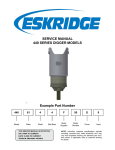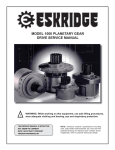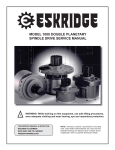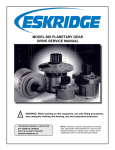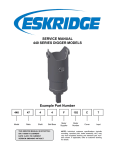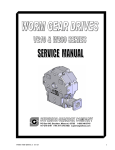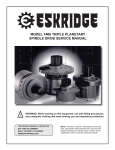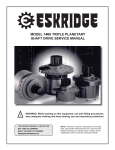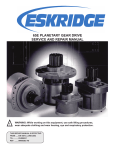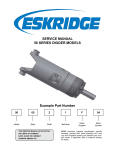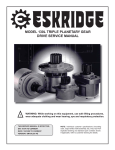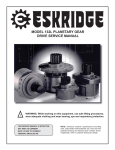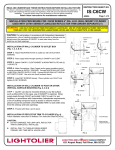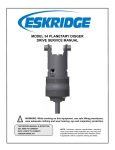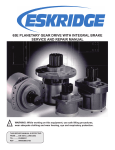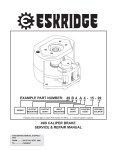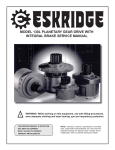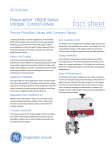Download Service Manual 1000 SerieS Digger MoDelS example Part number
Transcript
Service Manual 1000 Series Digger models Example Part Number 1000 96 5 4 f 97 E 5 Model Ratio Shaft Bail Boss Motor Supplier Motor Number Cover Input This service manual is effective: S/N: 89000 to current date: 1-2010 to CURRENT version:Smd100096-54f97e5_ab NOTE: Individual customer specifications (spindle mounting, sprocket pilot, brake assembly, etc.) may vary from exploded drawing and standard part numbers shown. If applicable, refer to customer drawing for details. Exploded View Drawing 100096-54F97E5 Eskridge ITEM 1 2 3 4 5 5A 5B 5C 5D 5E 5F 6 7 7A 7B 7C 7D 7E 7F 7G 7H 7J 7K 7L 8 8A 8B 8C 10 10A 10B 10C 11 11A 11B 11C 12 12A 12B 12C 12D 13 13A 13B 13C 13D 13E 13F 13G 14 15 15A 15B 15C 15D 15E 15F 16 MODEL 100096-54F97E5 DIGGER QTY 1 1 1 1 (1) 1 3 3 6 6 3 1 (1) 1 3 3 6 6 3 6 6 6 3 1 1 1 1 2 1 1 1 3 1 1 1 1 1 6 12 3 20 20 4 4 6 1 1 * 1 1 1 1 DESCRIPTION BASE-"F" FLANGLESS OUTPUT SHAFT: 5-1/4" SQUARE COVER (4 BOLT "E") INPUT GEAR CARRIER ASSEMBLY- PRIMARY CARRIER CLUSTER GEAR PLANET SHAFT BEARING (CAGE & ROLLER) THRUST WASHER ROLL PIN SUN GEAR CARRIER ASSEMBLY- SECONDARY CARRIER PLANET GEAR PLANET SHAFT BEARING CONE BEARING CUP RETAINING RING RETAINING RING WASHER SHIM ROLL PIN PLATE - SEC CARRIER RETAINER RING GEARS & SPACER RING GEAR - PRIMARY RING GEAR - SECONDARY RING SPACER THRUST WASHERS & BEARINGS BEARING THRUST RACE - PRIMARY BEARING - PRIMARY THRUST BEARING THRUST RACE - INPUT SEALS & O-RINGS O-RING O-RING OUTPUT SHAFT SEAL OUTPUT SHAFT BEARINGS OUTER CONE OUTER CUP INNER CONE INNER CUP HARDWARE SHCS (3/8-16 X 1) GR8 SHCS (1/2-13 X 1-1/2) GR8 FHS C.S. (3/8-24 X 1)GR8 HHCS (3/4-10 X 11.5) GR8 HARDWASHER (3/4 X 1.25 OD) HHCS (3/4-10 X 1.75) GR8 LOCKWASHER (3/4 MED) PIPE PLUG (3/4 NPT MAGNETIC) MISCELLANEOUS SEAL CARRIER BAIL ASSEMBLY SHIM LOCK RING SPLIT RING (L-SEGMENT) RETAINING RING MOTOR PART NO. 60-004-3014 60-004-4222L 60-004-1564 60-004-1462 60-005-2043 60-004-1024 60-004-1182 60-004-1272 01-105-0510 60-004-1881 01-153-0150 60-004-1222 60-005-2083 60-004-1044 60-004-1232 60-004-1262 01-102-0210 01-103-0210 01-160-0490 01-160-0500 60-004-1291 60-004-1321 01-153-0150 60-004-1352 60-004-1213 60-004-1243 60-004-1253 01-112-0350 01-112-0340 01-112-0060 01-402-0670 01-402-0660 01-405-0810 01-102-0190 01-103-0190 01-102-0220 01-103-0220 01-150-1110 01-150-0570 01-150-1590 01-150-1720 01-166-0350 01-150-1890 01-166-0360 01-207-0100 60-004-1922 60-005-1622 60-004-1311 60-004-1472 60-004-1482 01-160-0510 01-304-0970 13F 13G 16 13D 13E 15B 14 14 3 15F 11B 10C 4 10A 5A 8A 7C 7D 7E 7G 7K 7B 7E 7D 7H 7J 7H 7F 6 10B 5C 5E 5D 5B 5F 5E 13B 8C 11B 13C 7L 7A 8B 15D 15E 15C 12C 12D 11B 14 1 14 11C 12B 12A 11A 15A 13A 2 X100096-54F97E5aa 05-12-10 ECN- HWP Model D1000 service manual, SM 100096-54F97E5_AB Page Eskridge, Inc. Olathe, KS. 913-782-1238 www.eskridgeinc.com Lubrication & Maintenance Using the chart below, determine an appropriate lubricant viscosity. Use only EP (extreme pressure) or API GL-5 designated lubricants. Change the lubricant after the first 50 hours of operation and at 500 hour intervals thereafter. The auger drive should be partially disassembled to inspect gears and bearings at 1000 hour intervals. Recommended ambient and operating temperatures for conventional and synthetic gear lubricants -50 -25 0 25 50 75 100 125 150 175 200 225 250 F 107 121 C 80W90 conventional 75W90 conventional 85W140 conventional Min Ambient/operating temp Max Operating temp Max Ambient temp 75W90 synthetic 80W140 synthetic -45 -32 -18 -4 10 24 38 52 66 79 93 Note: Ambient temperature is the air temperature measured in the immediate vicinity of the gearbox. A gearbox exposed to the direct rays of the sun or other radiant heat sources will operate at higher temperatures and therefore must be given special consideration. The max operating temp must not be exceeded under any circumstances, regardless of ambient temperature. If your unit was specified “shaft up” or with a “-Z” option, a grease zerk was provided in the base housing. For shaft-up operation, the output bearing will not run in oil and must be grease lubricated. Use a lithium based or general purpose bearing grease sparingly every 50 operating hours or at regular maintenance intervals. Over-greasing the output bearing should be avoided as it tends to fill the housing with grease and thicken the oil ESKRIDGE MODEL D1000 OIL CAPACITIES Operating Position Oil Capacity Single stage Horizontal Shaft - Vertical Shaft (Pinion Down) ! Double stage Oil Level Triple stage - 9.5 gal To horizontal centerline of auger drive To midway on upper/ primary gear set WARNING: While working on this equipment, use safe lifting procedures, wear adequate clothing and wear hearing, eye and respiratory protection. ESKRIDGE PART NUMBER INTERPRETATION Note: All non custom Eskridge Geardrives are issued a descriptive part number which includes information regarding the Model, means of shaft retention, base style, shaft style, input mounting, input shaft size, overall ratio and various available options. For a detailed breakdown of this information, please refer to Eskridge product specification sheets found at: http://www.eskridgeinc.com/diggers/diggerprodspecs.html Model D1000 service manual, SM 100096-54F97E5_AB Page Eskridge, Inc. Olathe, KS. 913-782-1238 www.eskridgeinc.com Unit Disassembly Procedure Disassembly 1) Rotate planet gears (5B) to check for abnormal noise or roughness in bearings (5D) or planet shafts (5C). If further inspection or replacement is required, proceed as follows. 2) Drive roll pins (5F) completely into the planet shafts (5C). 3) Press or drive planet shafts (5C) out of carrier (5A). Remove the twenty hex-head capscrews (13D) and flat washers (13E). 4) Remove planet gears (5B) and thrust washers (5E) from the carrier (5A). 4) Separate bail (15B) from gearbox and remove from digger assembly. 5) Inspect the planet gear (5B) bearing bore, planet shaft (5C) and rollers (5D). Check for spalling, bruising or other damage. 5) Install two hex-head capscrews (13D) into cover (3) to retain gearbox assembly together while removing motor fasteners. 6) Replace any parts where abnormal wear is found. 6) Remove motor (16) from cover (3) and remove temporary fasteners (13D). 7) Use 3/16 inch pin punch to remove roll pins (5F) from planet shafts (5C). 7) Remove cover (3), thrust bearings (10A, 10B & 10C), remove input gear (4). Inspect o-ring (11B); discard if damaged or deformed. 1) Scribe a diagonal line across the outside of the unit from the bail (15B) to the base (1) before disassembly to aid in the proper positioning of pieces during reassembly. 2) Remove magnetic drain plugs (14) and drain oil from unit. The oil will drain out faster and more completely if warm. 3) 8) 9) Lift Stage I planet carrier assembly (5) out of the unit. Remove ring gear spacer (8C) and inspect o-ring (11B); discard if damaged or deformed. NOTE: If either the rollers or the planet shafts (pins) are damaged, both components should be replaced. Reassembly 1) Remove Stage II sun gear (6) from secondary carrier assembly (7). 10) Remove the three 3/8-24 flat head capscrews (13C) securing the carrier retaining plate (7L) to the output shaft (2). a) Set planet washer (5E) on work table, place planet gear (5B) onto washer and insert bearings (5D) into planet bore. b) Place planet washer (5E) onto top of planet gear then slide the gear into carrier (5A). (Oriented as shown.) 2) Planet shafts (5C) should be installed with chamfered end of 3/16 inch hole toward outside diameter of the carrier (5A). This will aid in alignment of holes while inserting roll pins (5F). 3) Drive a roll pin (5F) through the carrier hole and into the planet shaft to retain the parts. Repeat for other planet gears. 11) Remove remaining ring gear (8B) and Stage II carrier assembly (7). Inspect gear to gear and gear to base o-ring(s) (11B), discard and replace any damaged or deformed o-rings. 12) The unit is now separated into subassemblies. The area(s) requiring repair should be identified by thorough inspection of the individual components after they have been cleaned and dried. To install rollers in planet gear bore: Stage I Carrier Subassembly (Items 5A, 5B, 5C, 5D, 5E, & 5F) 5C 5E 5D 5B 5F 5E 5A Model D1000 service manual, SM100096-54F97E5_AB Page Eskridge, Inc. Olathe, KS. 913-782-1238 www.eskridgeinc.com Base Subassembly Stage II Carrier Subassembly (Items 1, 2, 11C, 12A, 12B, 12C, 12D, 14, 15A, 15C, 15D, & 15E) (Items 7A, 7B, 7C, 7D, 7E, 7F, 7G, 7H, 7J & 7K) 7C 7D 7E 7G 7K 7B 7E 7D 7H 7J 7H 7F 15D 15E 15C 11B 14 1 12B 12A 11A 15A 14 7A 11C Rotate planet gears (7B) to check for abnormal noise or roughness in bearings (7D, 7E). If further inspection or replacement is required, proceed as follows. 13A 2 Disassembly 1) 12C 12D Disassembly 1) Remove the seal carrier retaining screws (13A) and seal carrier (15A) from unit. Inspect seal (11C) and o-ring (11A) for signs of wear or damage and replace as necessary. 2) Remove the lock ring (15D) using a heel bar or puller; if using a heel bar, be sure not to pry against the cage of the inner output shaft bearing (12C). Remove the split ring segments (15E) and shims (15C). 2) Removing retaining ring (7F), washer (7H) and shims (7J) from planet shaft (7D). 3) Press planet shafts (7C) out of carrier (7A). 4) Remove planet gears (7B) and washer (7H) from carrier. 5) Inspect the planet gear (7B), bearing cone (7D), bearing cup (7E) and planet shaft (7C). Check for spalling, bruising or other damage. Replace components as necessary; bearing need to be replaced as a cup and cone set. Caution: Since the output shaft is no longer retained, care should be taken to avoid personal injury. Care should also be taken not to damage it when it is pressed through base. 6) Replace any parts where abnormal wear is found. 3) Reassembly 1) Rebuild Stage II planet carrier assembly in reverse order using any needed new parts. 2) Install bearing cones (7D) into planet gear bearing cups (7E). Place washer (7H) onto interior carrier spot faced surface. 3) Insert planet gear assembly into carrier (7A). Slide planet shaft (7C) Into carrier planet assembly and align planet pin notch with roll pin in carrier. 4) Place shims (7J) and washer (7H) onto planet shaft. Install retaining ring (7F). Rotate plant gears by hand to test bearing preload. Correct bearing preload on the planet gears requires 50-75 in-lbs rotating torque. If gear doesn’t rotate remove a shim and test again until a smooth loaded rotation is developed. Repeat for remaining planet gears. Base (1) should be set pinion side down, as shown, on a plate or table. Press output shaft through the bottom of base by applying a load to top end (internal end) of shaft until it passes through inner shaft bearing cone (12C). Note: Removing the shaft from the base assembly damages the shaft seal and the seal will need to be replaced. 4) A gear puller may be used to remove the outer bearing cone (12A) from the shaft (2). If reusing old bearing cone, do not pull on or damage roller cage. 5) Inspect inner and outer bearing cups (12A, 12B, 12C & 12D). If cups are damaged, drive them out using a brass drift and utilizing the bearing knock-out notches in the base (1) Reassembly 1) Clean all foreign material from magnetic oil plug (14) located on the side of the base (1). 2) Place base (1) (output side up, opposite shown) on the table. 3) Apply a layer of lithium or general purpose bearing grease to the roller contact surface of outer bearing cup (12A). 4) Press outer bearing cone (12B) (large end down as shown) onto the shaft until it seats against the shoulder. Model D1000 service manual, SM100096-54F97E5_AB Page Eskridge, Inc. Olathe, KS. 913-782-1238 www.eskridgeinc.com Note: Press bearing cone onto output shaft by pressing on inner race only. DO NOT press on roller cage, as it may damage bearing. 5) Place the shaft (2) with the bearing (12A) into the base (1). 6) Flip this assembly, resting the base (1) on the end of the output shaft (2). 7) Apply a layer of lithium or general purpose bearing grease to the roller contact surface of the inner cup (12D). Press the inner bearing cone (12C) (large end up as shown) onto the shaft (2) until it is seated against inner bearing cup (12D). 8) Without the shaft seal (11C) installed, the preload may result in a rolling torque that varies between 50 to 300 in-lb. The bearing preload should be tailored to your application; a lowspeed application may require a high pre-load, high-speed applications usually benefit from low pre-load. Adding shims (15C) will increase the pre-load on the bearing set. Determine your pre-load requirement and install shims to obtain this pre-load. Install the Load-N-Lock™ segments (15E) over the shims (15C) and into the groove in the shaft (2). Finally, install the lock ring (15D) over the segments (15E). 9) b) As seen from above, start with the top planet gear and position it’s timing mark pointing straight down. Next, rotate the lower left planet gear counterclockwise as indicated in the timing diagram. Then rotate the lower right planet gear clockwise as indicated. Install o-ring (11A) onto seal carrier (15A). Lubricate inner lip of new shaft seal (11B) and slide seal carrier assembly onto the shaft (2). Install seal carrier fasteners (13A) and torque to 30 ft-lbs. c) Set the input gear (4) and the input thrust race (10C) into the center of the primary planet carrier assembly. All subassembly service or repairs should be complete at this time. Continue to Unit Assembly to complete unit buildup. d) If compound primary ring gear (8A) was not removed during disassembly, then skip to step 9. Otherwise, bolt to the inside of the cover (3) with twelve bolts (13B). Use a removable thread locking compound on the threads of the bolts. Tighten to 110 ft.-lbs. dry or 80 ft.-lbs. lubricated. Unit Assembly 1) When all subassemblies are complete, the unit is ready to be assembled. 2) Install the Stage II carrier assembly onto the output shaft; align the splines of the carrier (7A) with the splines of the shaft (2) and slide the carrier onto the shaft. 3) Install carrier retaining plate (7L) & secure using 3/8-24 Flathead capscrews (13C). 4) Lubricate o-ring (11B) and install on the pilot of the Stage II ring gear (8B). Caution: Hold ring gear by outside or use lifting device to prevent injury. 5) Install Stage II sun gear (6) into Stage II carrier assembly. 6) Align gear teeth of ring gear (8B) with the gear teeth of the planet gears (7B) and place on base. Align mounting holes of ring gear with holes in base. Using the scribed line made during disassembly for reference. 7) Place Stage I carrier (5A) onto Stage II sun gear (6). 8) Lubricate o-ring (11B) and install on the pilot of the Stage I ring gear spacer (8B). Install spacer. 9) Compound primary timing instructions: a) The planet gears will now need to be timed. Refer to the diagram. The planet gears each have a timing mark, usually a round punch locate timing marks on planet gear (5B). 9) Install thrust washer (10A) onto primary carrier then install thrust bearing (10B) and thrust washer (10A). 10) Lubricate o-ring (11B) and install on the pilot of the cover (3). 11) Noting the scribed line made during disassembly, install the cover (3). Install 2 fasteners (13D) to retain unit together. 12) Ensure the unit spins freely by using a splined shaft to drive the input gear (4). If unit does not rotate freely for one revolution remove cover and verify primary planet gearing is timed correctly. 13) Install motor (16) onto cover (3) and align motor shifting mechanism with bail relief hole. Install motor fasteners. 14) Remove two temporally fasteners installed in step 11. Place bail (15B) onto assembly and aligning holes in bail and cover using scribed line made during disassembly as a reference. Install and torque the 20 3/4-10 hex head capscrews (13D) with flat washers (13E). The torque for the capscrews is 380 ft-lbs dry, 280 ft-lbs if fasteners are lubricated. 15) Fill the unit to the proper level, as specified, with GL5 EP 80/90 gear oil after it is sealed with the motor. The digger is now ready to use. Model D1000 service manual, SM100096-54F97E5_AB Page Eskridge, Inc. Olathe, KS. 913-782-1238 www.eskridgeinc.com






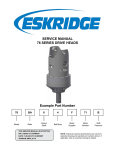
![E-CORE[イー・コア]直管形LEDベースライト モデルチェンジのお知らせ](http://vs1.manualzilla.com/store/data/006543989_3-984d60b7a35b5c906359937cb576f3e5-150x150.png)
